Compressive Bearing Capacity and Ductility of Slurry-Infiltrated Fiber Concrete Blocks with Two-Dimensional Distributed Steel Fibers
Abstract
1. Introduction
2. Specimen Design and Basic Material Properties
2.1. Materials
2.2. SIFCON Blocks
3. Compressive Bearing Capacity and Ductility of SIFCON Blocks
3.1. Compression Test of SIFCON Blocks
3.2. Compressive Bearing Capacity of SIFCON Blocks
3.3. Ductility of SIFCON Blocks
3.4. Rationality of the Custom-Made Steel Fiber Directional Placement Device
4. Conclusions
- (1)
- The custom-made steel fiber directional placement device offers cost-effective customization and enhances the uniformity of steel fiber distribution. Those with directional placement exhibit superior bearing capacity and ductility ratios compared to blocks without the device.
- (2)
- The bearing capacity of SIFCON blocks shows a linear decline with increasing fly ash substitution rate. At the same time, it follows a power function with the rise in steel fiber aspect ratio and linear growth with higher steel fiber volume fractions. Notably, the bearing capacity diminishes by 31% when the fly ash substitution increases from 0% to 40%, while it increases by 19% and 33% with steel fiber aspect ratio increments from 33 to 70 and volume fraction increases from 10% to 14%, respectively.
- (3)
- The ductility of SIFCON blocks experiences significant enhancement with greater fly ash substitution rate, steel fiber aspect ratio, and volume fraction. The ductility ratio of the specimen increased by 99% when the fly ash substitution was increased from 0% to 40%, while ratios increase by 104% and 37% with aspect ratio increases from 33 to 70 and volume fraction increases from 10% to 14%, respectively.
5. Future Research
Author Contributions
Funding
Institutional Review Board Statement
Informed Consent Statement
Data Availability Statement
Conflicts of Interest
References
- Kar, D.R.L. Properties, applications: Slurry infiltrated fiber concrete (SIFCON). Concr. Int. 1984, 6, 44–47. [Google Scholar]
- Homrich, J.R.; Naaman, A.E. Stress-strain properties of SIFCON in compression. ACI Mater. J. 1987, 105, 283–304. [Google Scholar]
- Naaman, A.E.; Homrich, J.R. Tensile stress-strain properties of SIFCON. Mater. J. 1989, 86, 244–251. [Google Scholar]
- Naaman, A.E.; Otter, D.; Najm, H. Elastic modulus of SIFCON in tension and compression. ACI Mater. J. 1992, 88, 603–613. [Google Scholar]
- Wu, Y.F. New avenue of achieving ductility for reinforced concrete members. J. Struct. Eng. 2006, 132, 1502–1506. [Google Scholar] [CrossRef]
- Liu, X.C.; Wu, Y.; Leung, A.; Hou, J. Mechanical Behavior of Mild Steel Compressive Yielding Blocks. In Proceedings of the First Asia-Pacific Conference on FRP in Structures, Hong Kong, China, 12–14 December 2007; pp. 12–14. [Google Scholar]
- Aravind, V.; Pradeepa, S. Experimental Study on Slurry Infiltrated Fibre Reinforced Concrete with Partial Replacement of Fly Ash. Int. J. Eng. Manag. Res. 2015, 5, 169–174. [Google Scholar]
- Preetha, R.; Joanna, P.; Rooby, J.; Pillai, C.S. Ductility behavior of reinforced high volume fly ash concrete beams. Int. J. Sci. Eng. Res. 2013, 4, 123–126. [Google Scholar]
- Liu, C.; Bi, Y.; Hua, Y. Mechanical Properties of PVA-ECC with High Volume Fly Ash and Mechanism Analysis of Fly Ash. Bull. Chin. Ceram. Soc. 2017, 36, 3739–3744. [Google Scholar]
- Elavarasi, D.; Mohan, K.S.R. Effect of fly ash on strength and durability of slurry infiltrated fibrous concrete. Rev. Romana Mater. 2018, 48, 529. [Google Scholar]
- Huang, J. Experimental Study on Mechanical Properties and Hydration Process of High Volume Fly Ash-Cement-Based Materials. Master’s Thesis, Zhejiang University of Technology, Hangzhou, China, 2020. [Google Scholar]
- Yıldızel, S.A.; Özkılıç, Y.O.; Bahrami, A.; Aksoylu, C.; Başaran, B.; Hakamy, A.; Arslan, M.H. Experimental investigation and analytical prediction of flexural behaviour of reinforced concrete beams with steel fibres extracted from waste tyres. Case Stud. Constr. Mater. 2023, 19, 02227. [Google Scholar] [CrossRef]
- Fayed, S.; Madenci, E.; Bahrami, A.; Özkiliç, Y.O.; Mansour, W. Experimental study on using recycled polyethylene terephthalate and steel fibers for improving behavior of RC columns. Case Stud. Constr. Mater. 2023, 19, 02344. [Google Scholar] [CrossRef]
- Özkılıç, Y.O.; Aksoylu, C.; Arslan, M.H. Experimental and numerical investigations of steel fiber reinforced concrete dapped-end purlins. J. Build. Eng. 2021, 36, 102119. [Google Scholar] [CrossRef]
- Tuyan, M.; Yazıcı, H. Pull-out behavior of single steel fiber from SIFCON matrix. Constr. Build. Mater. 2012, 35, 571–577. [Google Scholar] [CrossRef]
- Huang, Y.; Wu, Y.F. Ductility of Hybrid Fiber Reinforced Concrete. In Proceedings of the International Symposium on Innovation & Sustainability of Structures in Civil Engineering, Nanjing, China, 20–22 November 2005; pp. 20–22. [Google Scholar]
- Hamed, H.A.; Abass, Z.W. Effect of steel fiber proportion on SIFCON mechanical properties. J. Eng. Sustain. Dev. 2022, 26, 55–63. [Google Scholar] [CrossRef]
- Wood, B.T. Use of Slurry Infiltrated Fiber Concrete (SIFCON) in Hinge Regions of Earthquake Resistant Structures. Ph.D. Thesis, North Carolina State University, Raleigh, NC, USA, 2001. [Google Scholar]
- Abdollahi, B.; Bakhshi, M.; Mirzaee, Z.; Shekarchi, M.; Motavalli, M. SIFCON strengthening of concrete cylinders in comparison with conventional GFRP confinement method. Constr. Build. Mater. 2012, 36, 765–778. [Google Scholar] [CrossRef]
- Parameswaran, V.; Krishnamoorthy, T.; Balasubramanian, K.; Gangadar, S. Studies on slurry-infiltrated fibrous concrete (SIFCON). Transport. Res. Rec. 1993, 1382, 57–63. [Google Scholar]
- Lin, Z.W.; Shui, Z.H.; Yu, R.; Song, Q.L.; Xiao, X.G. Effect of Casting Method on Fiber Orientation and Distribution in Ultra-High Performance Fibre Reinforced Concrete (UHPFRC). Bull. Chin. Ceram. Soc. 2019, 38, 2010–2015. [Google Scholar]
- Huang, S.W.; Guo, Z.W.; Liu, X.F.; He, C.X.; Wang, H.; Duan, X.Z.; Bai, W.L.; Ben, H. Method for Directional Arrangement of Steel Fibers In Ultra-High Performance Concrete: China. Patent 110552508 A 2019. [Google Scholar]
- Mu, R.; Tian, W.L. Investigation on the preparation and properties of aligned steel fibre reinforced cement paste. J. Hebei Univ. Technol. 2012, 41, 101–104. [Google Scholar]
- Wu, Y.F.; Jiang, J.F.; Liu, K. Perforated SIFCON blocks-An extraordinarily ductile material ideal for use in compression yielding structural systems. Constr. Build. Mater. 2010, 24, 2454–2465. [Google Scholar] [CrossRef]
- Wu, Y.F.; Zhou, Y.W.; He, X.Q. Performance-based optimal design of compression-yielding FRP-reinforced concrete beams. Composite Struct. 2010, 93, 113–123. [Google Scholar] [CrossRef]
- Wu, Y.; Jiang, J.F.; Liu, K. Analysis and Design of Perforated SIFCON Blocks for Compression Yielding Structural Systems. In Proceedings of the Third Asia-Pacific Conference on FRP in Structures (APFIS 2012), Sapporo, Japan, 2–4 February 2012; International Institute for FRP in Construction: Sapporo, Japan, 2012; pp. 1–5. [Google Scholar]
- Liu, K. Experimental Study on the Ductility of SIFCON Blocks. Adv. Mater. Res. 2014, 838, 530–534. [Google Scholar] [CrossRef]
- GB 175-2020; General Portland Cement. China Standard Press: Beijing, China, 2020.
- GB/T 1596-2017; Fly Ash for Cement and Concrete. China Standard Press: Beijing, China, 2017.
- Liu, K.; Wu, Y.F. Compression yielding by SIFCON block for FRP-reinforced concrete beams. In Proceedings of the Asia-Pacific Conference on FRP in Structures, Hong Kong, China, 12–14 December 2007; Shatin Storage Book Collection: Hong Kong, China, 2007; p. 411. [Google Scholar]
- Zhou, Y.; Wu, Y.; Teng, J.; Leung, A. Ductility analysis of compression-yielding FRP-reinforced composite beams. Cem. Concr. Compos. 2009, 31, 682–691. [Google Scholar] [CrossRef]
- Zhou, Y.W.; Wu, Y.F.; Teng, J.G.; Leung, A.Y.T. Parametric space for the optimal design of compression-yielding FRP-reinforced concrete beams. Mater. Struct. 2010, 43, 81–97. [Google Scholar] [CrossRef]
- Zhou, Y.W.; Zhuang, L.; Hu, Z.; Hu, B.; Huang, X.; Zhu, Z. Perforated steel for realizing extraordinary ductility under compression: Testing and finite element modeling. Rev. Adv. Mater. Sci. 2022, 61, 195–207. [Google Scholar] [CrossRef]
- GB/T 50448-2015; Technical Specification for Application of Cement-Based Grouting Materials. China Standard Press: Beijing, China, 2015.
- Efnarc, F. Specification and guidelines for self-compacting concrete. Eur. Fed. Spec. Constr. Chem. Concrete Syst. 2002, 2, 1–28. [Google Scholar]
- Manolia, A.A.; Shakir, A.S.; Qais, J.F. The effect of fiber and mortar type on the freezing and thawing resistance of Slurry Infiltrated Fiber Concrete (SIFCON). In Proceedings of the IOP Conference on Materials Science and Engineering, Istanbul, Turkey, 8 August 2018; IOP: Suzhou, China, 2018; Volume 454, p. 012142. [Google Scholar]
- Li, H.; Li, Y.; Pan, Y.; Ng, P.L.; Leung, C.K.Y.; Zhao, X. Compressive properties of a novel slurry-infiltrated fiber concrete reinforced with arc-shaped steel fibers. J. Zhejiang Univ. Sci. A 2023, 24, 543–556. [Google Scholar] [CrossRef]
- Mehta, P.K. High-performance, high-volume fly ash concrete for sustainable development. In Proceedings of the International Workshop on Sustainable Development and Concrete Technology, Beijing, China, 20–21 May 2004; Iowa State University: Ames, IA, USA, 2004; pp. 3–14. [Google Scholar]
- Jau, W.C.; Fu, C.W.; Yang, C.T. Study of feasibility and mechanical properties for producing high-flowing concrete with recycled coarse aggregates. In Proceedings of the International Workshop on Sustainable Development and Concrete Technology, Beijing, China, 20–21 May 2004; pp. 89–102. [Google Scholar]
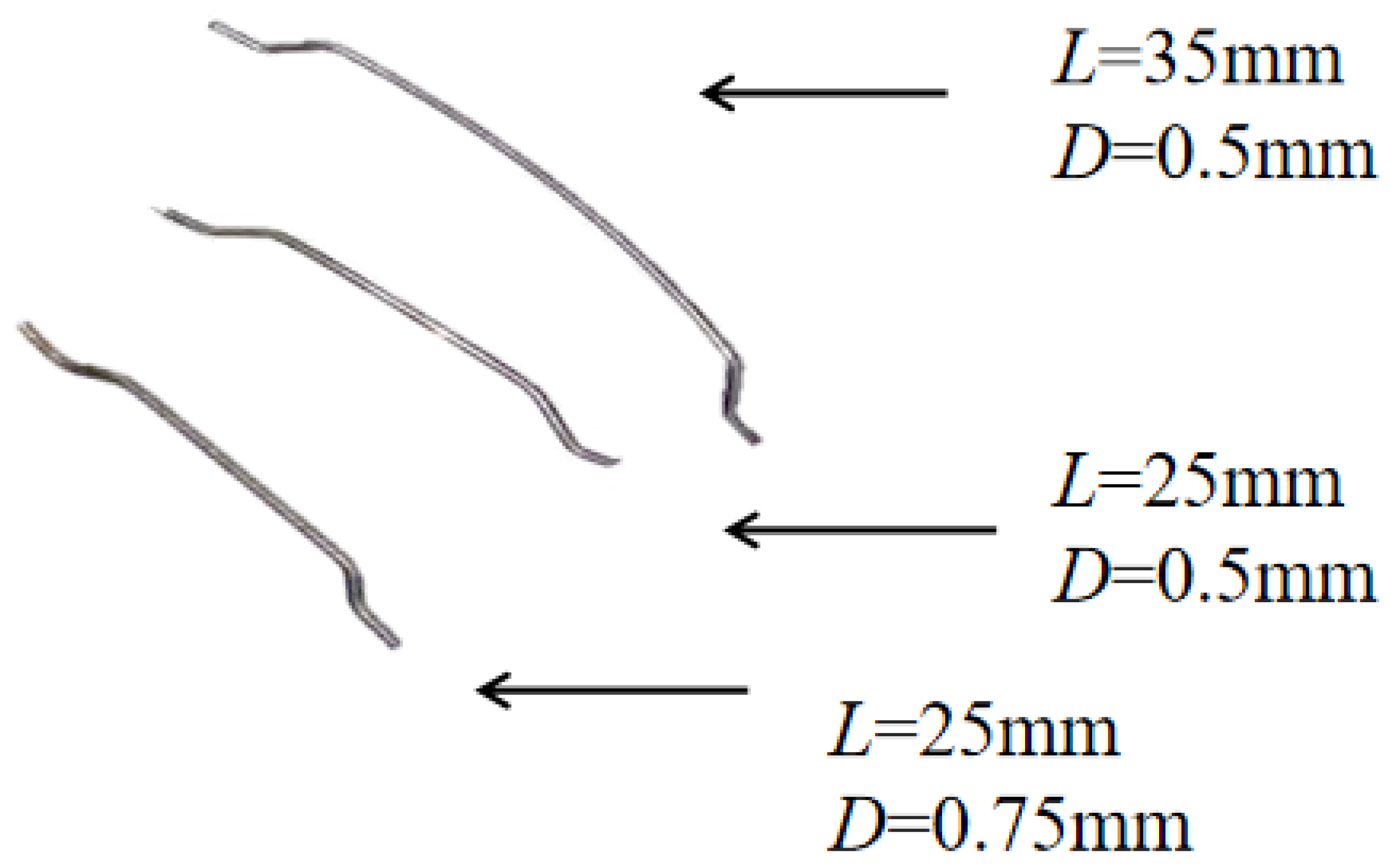
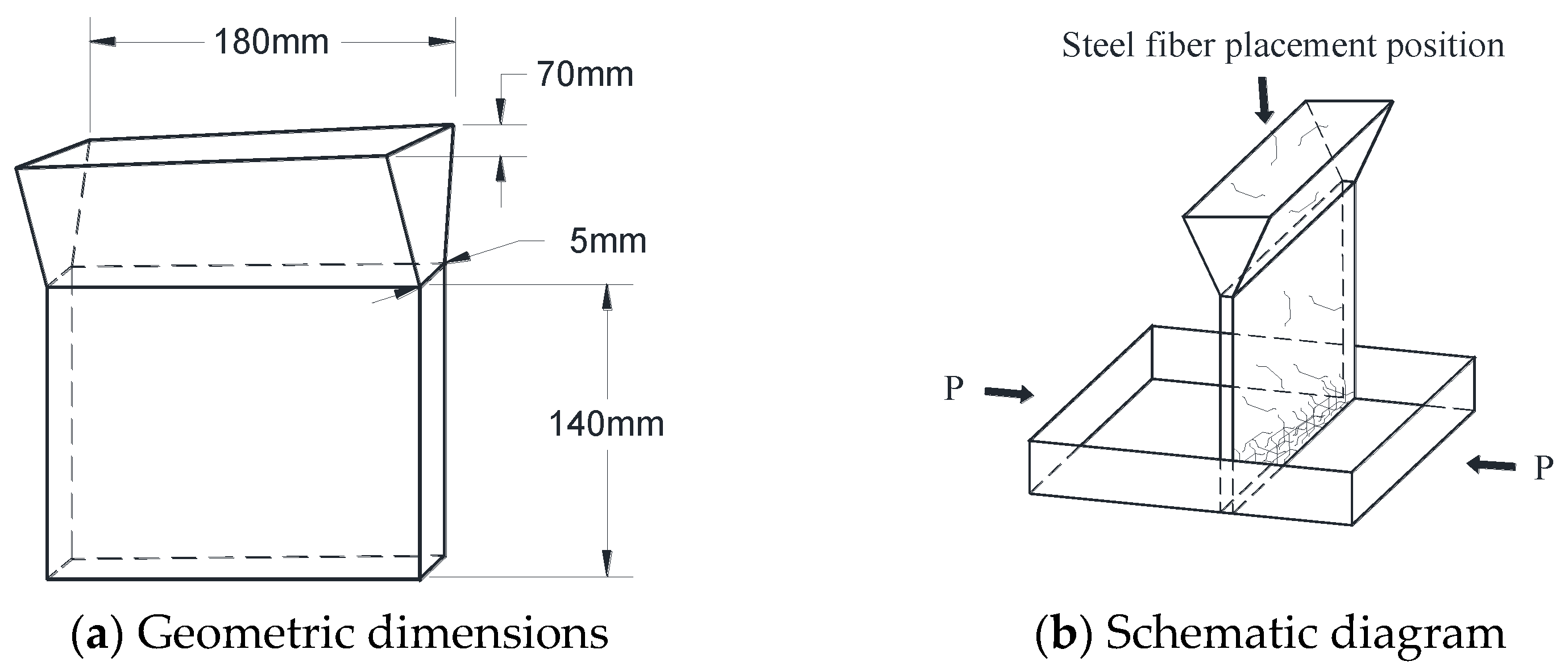

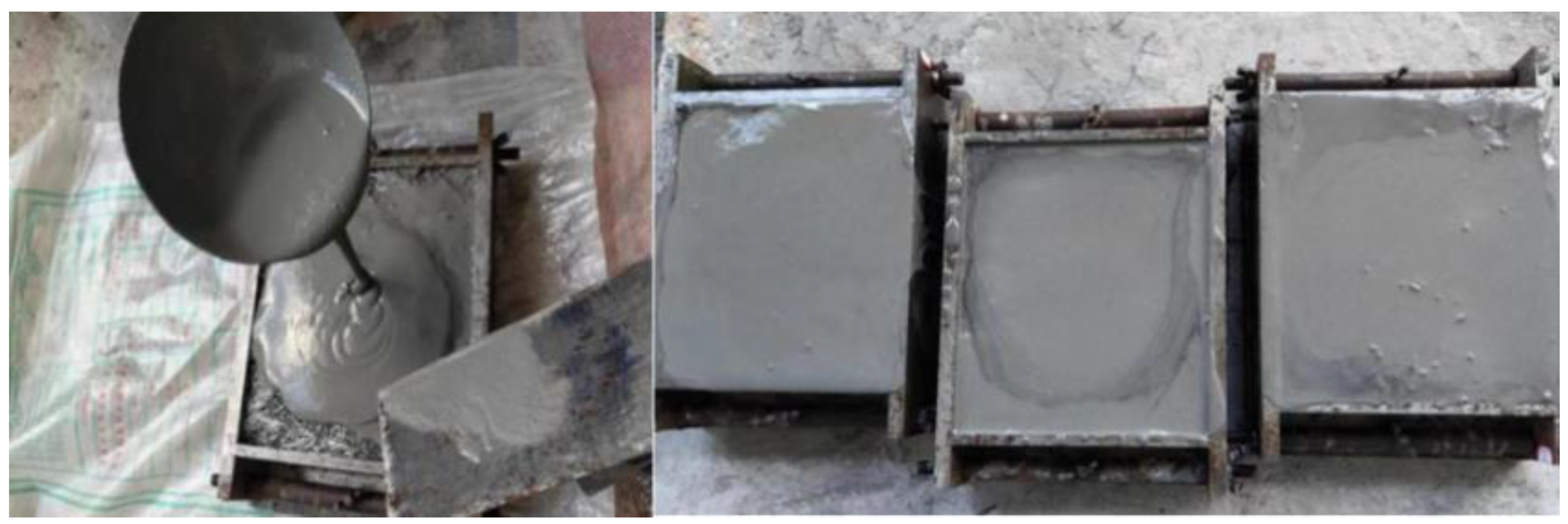

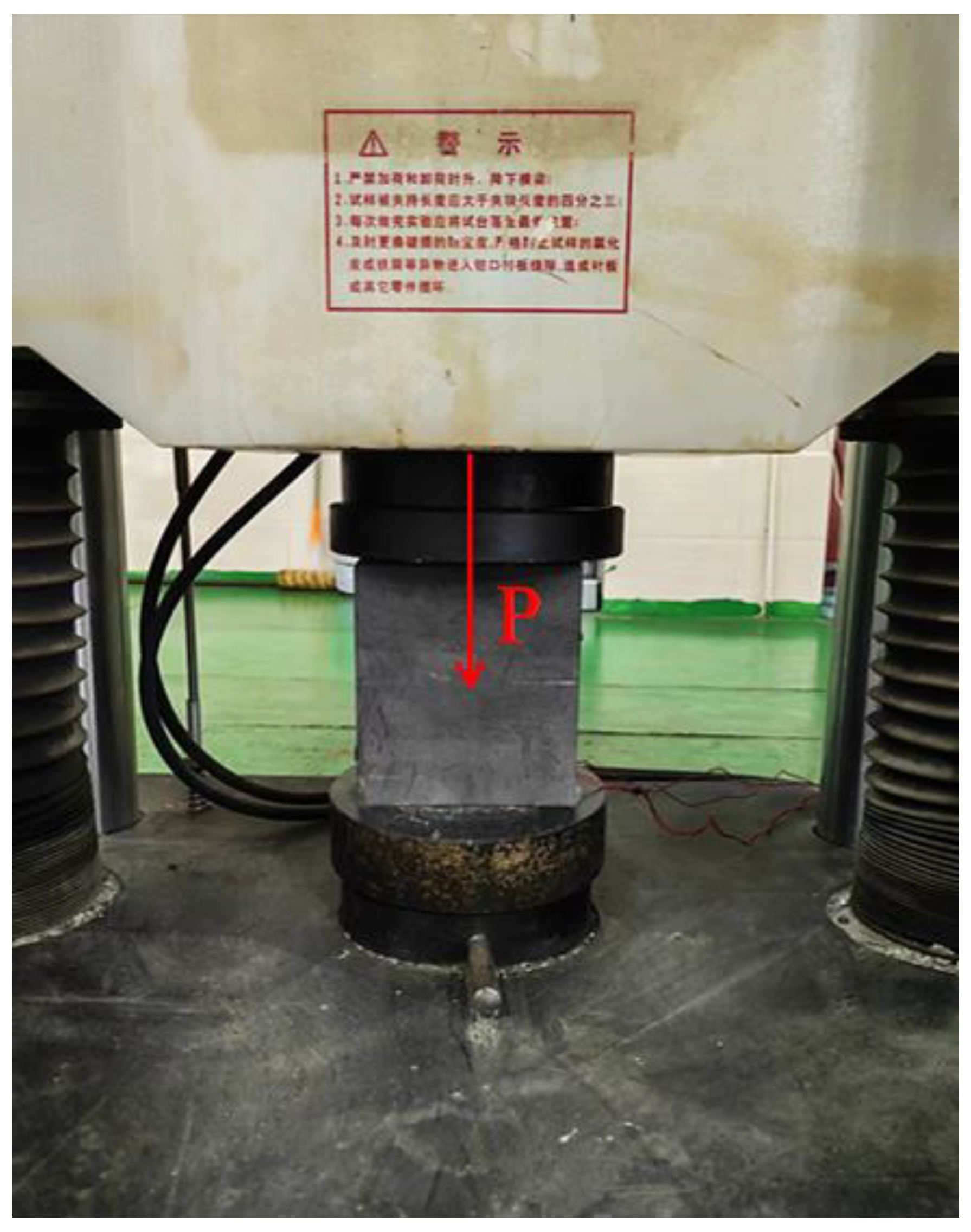

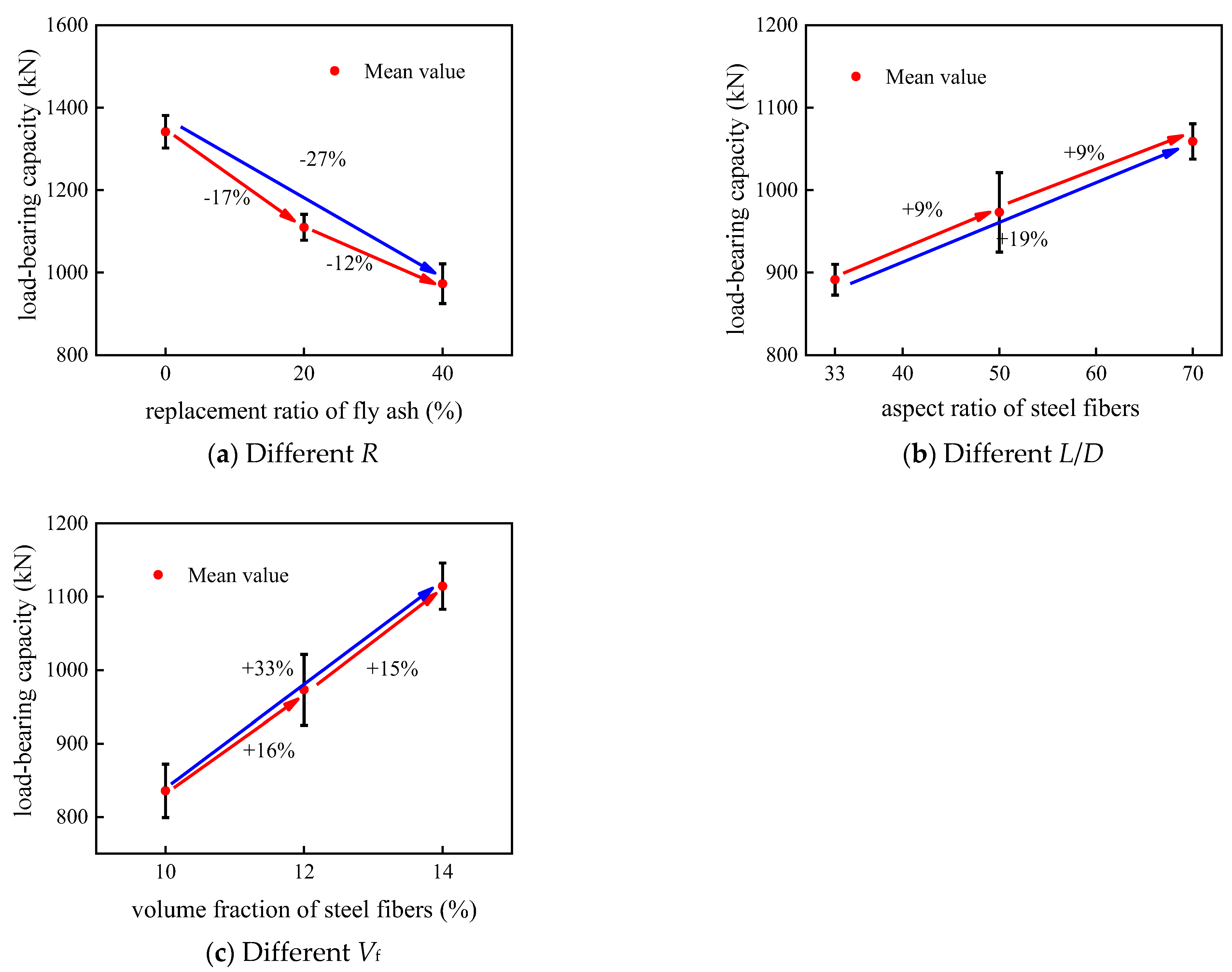
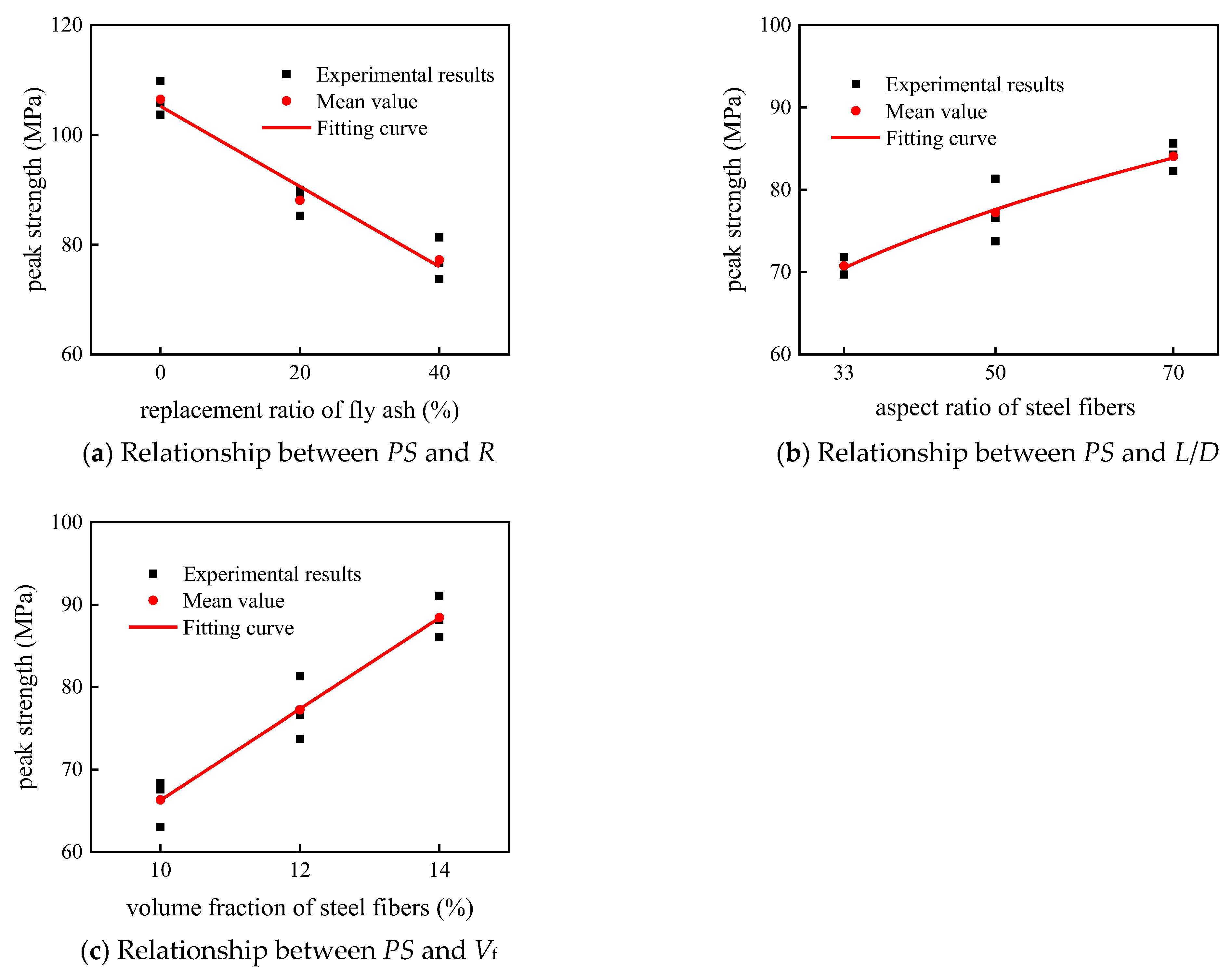
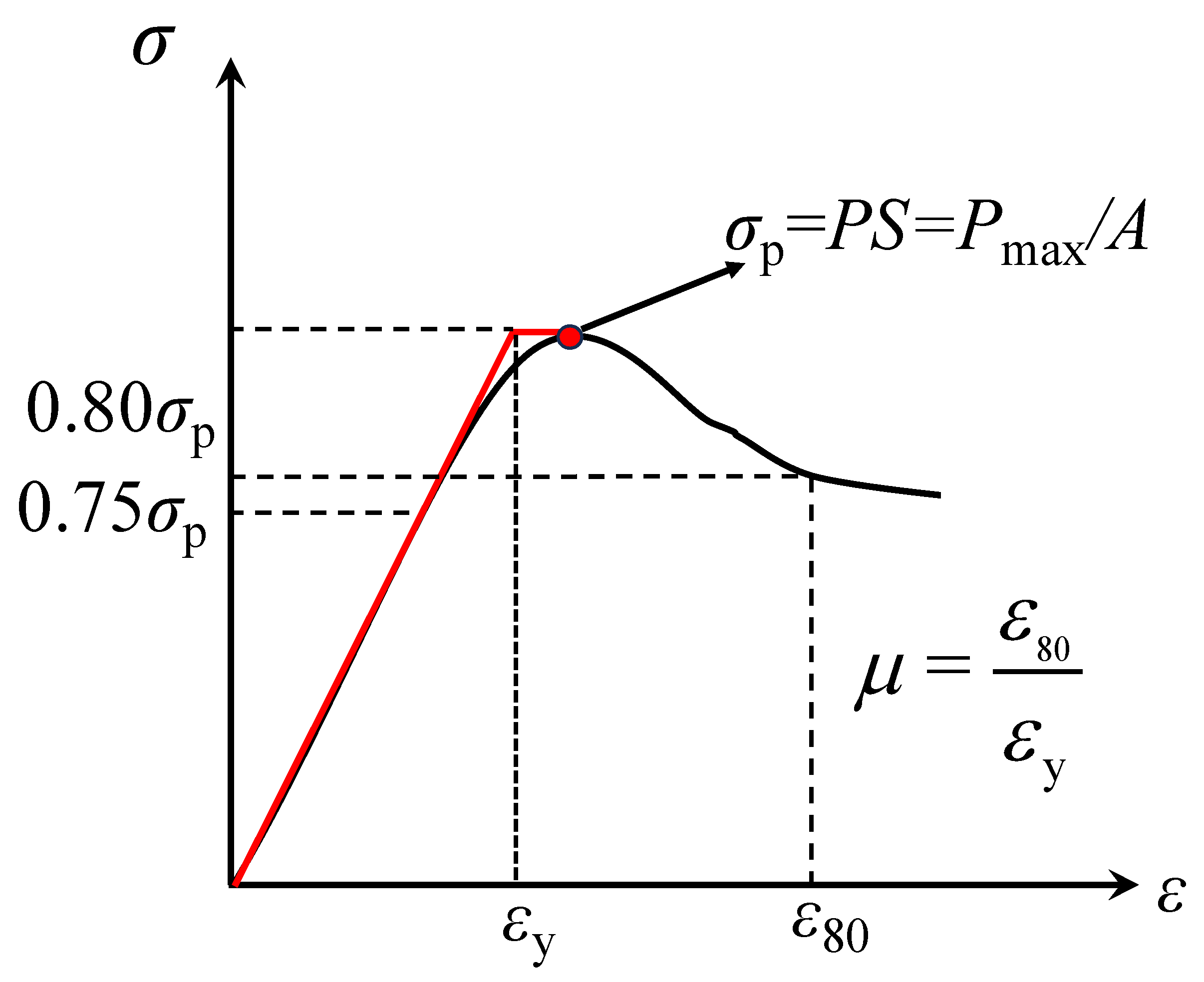
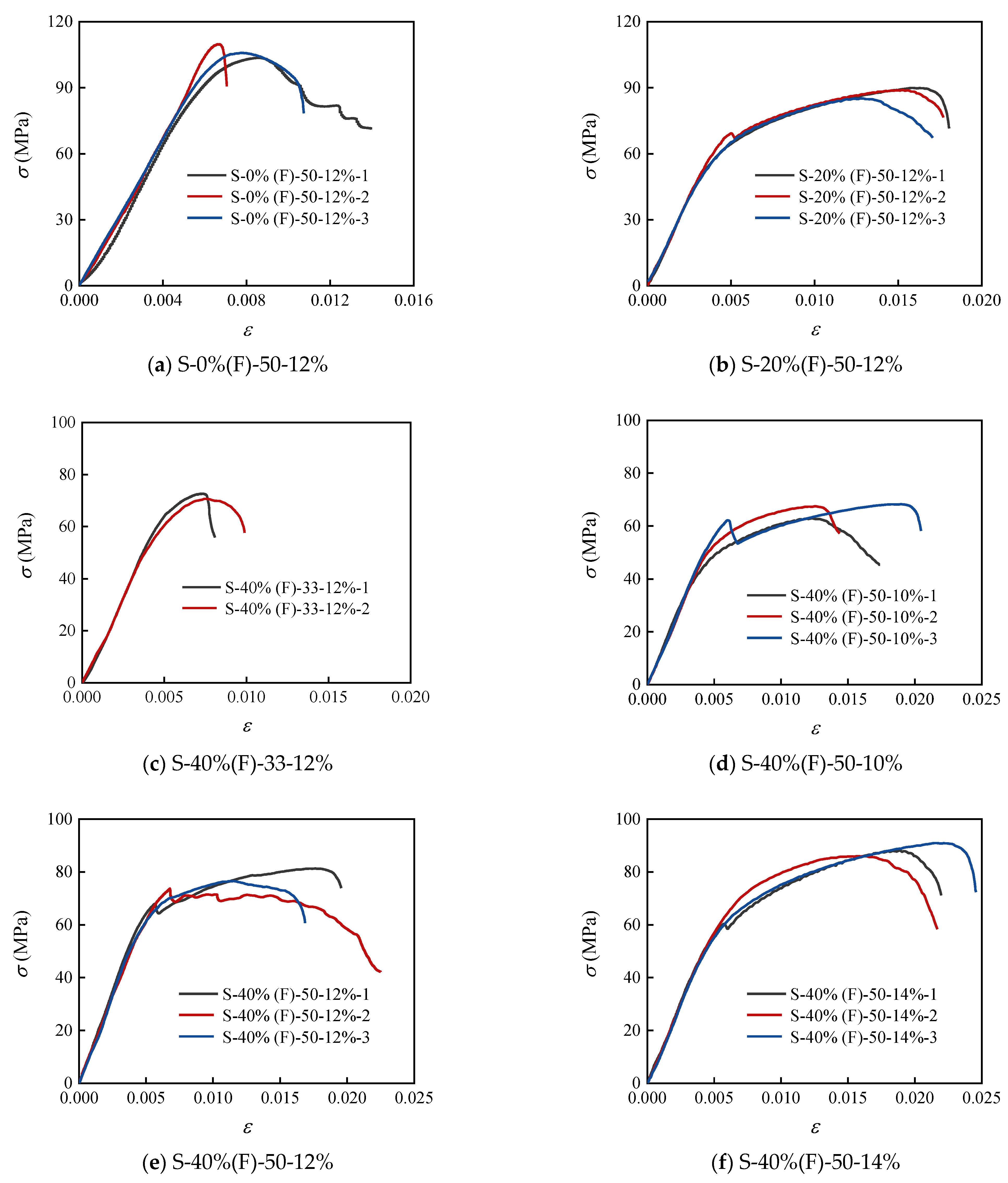
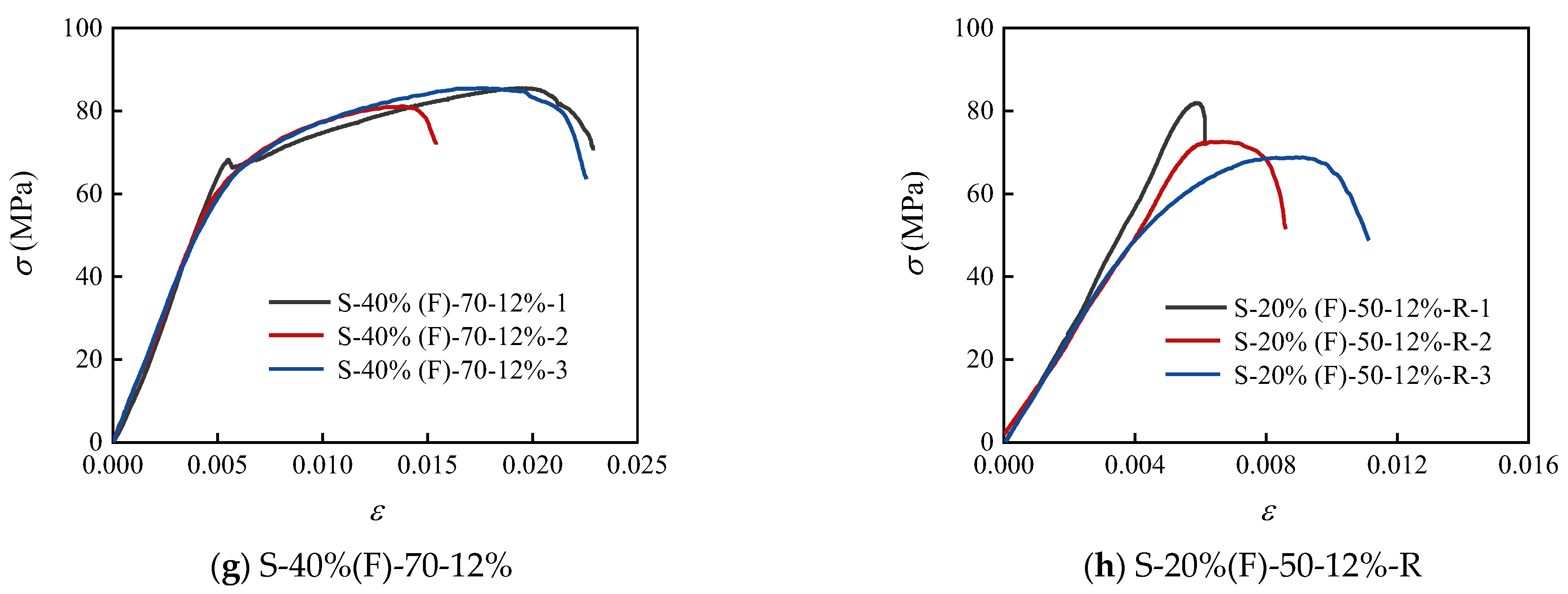
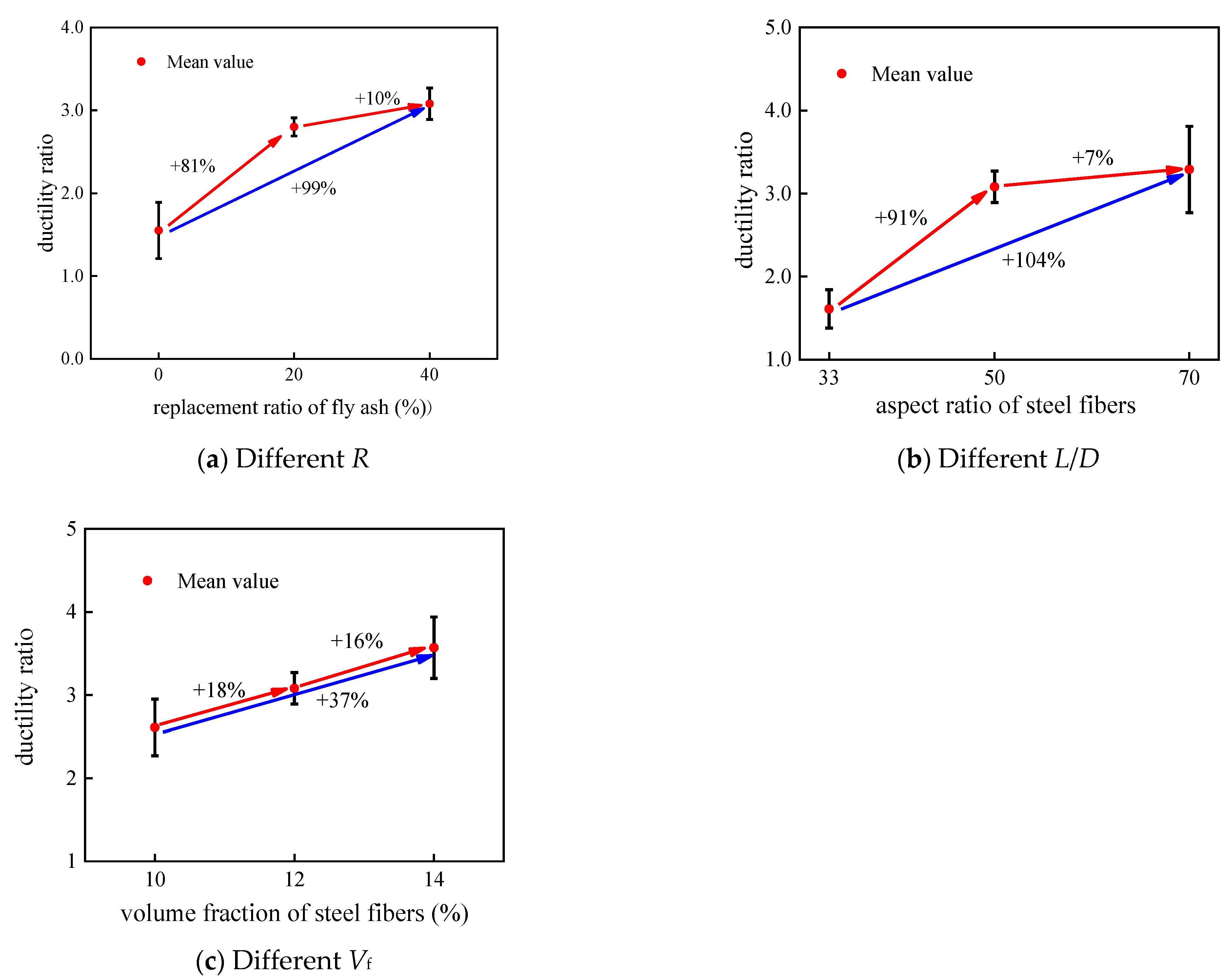

| Material | Specific Surface Area (m2/kg) | Initial Setting Time (min) | Final Setting Time (min) | Three-Day Flexural Strength (MPa) | Three-Day Compressive Strength (MPa) | Twenty-Eight-Day Flexural Strength (MPa) | Twenty-Eight-Day Compressive Strength (MPa) |
|---|---|---|---|---|---|---|---|
| Cement | 358 | 172 | 234 | 5.5 | 27.2 | 8.4 | 49 |
| Material | Fineness (%) | Densities (g/cm3) | Water Demand Ratio (%) | Heat Loss Rate (%) | Moisture Content (%) |
|---|---|---|---|---|---|
| Fly ash | 10.8 | 2.3 | 91.5 | 4.6 | 0.5 |
| Aspect Ratio | L (mm) | D (mm) | Tensile Strength (MPa) | Density (g/cm3) |
|---|---|---|---|---|
| 33 | 25 | 0.75 | 1150 | 7.8 |
| 50 | 25 | 0.5 | ||
| 70 | 35 | 0.5 |
| Blocks | R (%) | L/D | Vf (%) | Number |
|---|---|---|---|---|
| S-0%(F)-50-12% | 0 | 50 | 12 | 3 |
| S-20%(F)-50-12% | 20 | 50 | 12 | 3 |
| S-40%(F)-33-12% | 40 | 33 | 12 | 3 |
| S-40%(F)-50-10% | 50 | 10 | 3 | |
| S-40%(F)-50-12% | 12 | 3 | ||
| S-40%(F)-50-14% | 14 | 3 | ||
| S-40%(F)-70-12% | 70 | 12 | 3 | |
| S-20%(F)-50-12%-R | 20 | 50 | 12 | 3 |
| R | Mini Slump Flow (mm) | V-Shaped Funnel (s) | Mean Cubic Compressive Strength (MPa) |
|---|---|---|---|
| 0% | 249 | 9.08 | 56.33 |
| 20% | 271 | 7.87 | 50.17 |
| 40% | 315 | 7.02 | 43.02 |
| Blocks | - | Compressive Bearing Capacity (kN) | Peak Strength (MPa) |
|---|---|---|---|
| S-0%(F)-50-12% | 1 | 1306.12 | 103.66 |
| 2 | 1383.98 | 109.84 | |
| 3 | 1334.59 | 105.92 | |
| Mean | 1341.56 | 106.47 | |
| Standard deviation | 39.40 | 3.13 | |
| S-20%(F)-50-12% | 1 | 1134.13 | 90.01 |
| 2 | 1121.40 | 89.00 | |
| 3 | 1074.28 | 85.26 | |
| Mean | 1109.94 | 88.09 | |
| Standard deviation | 31.53 | 2.50 | |
| S-40%(F)-33-12% | 1 | 904.68 | 71.8 |
| 2 | 878.22 | 69.7 | |
| 3 | * | * | |
| Mean | 891.45 | 70.75 | |
| Standard deviation | 18.71 | 1.48 | |
| S-40%(F)-50-10% | 1 | 794.05 | 63.02 |
| 2 | 851.76 | 67.60 | |
| 3 | 861.21 | 68.35 | |
| Mean | 835.67 | 66.32 | |
| Standard deviation | 36.36 | 2.89 | |
| S-40%(F)-50-12% | 1 | 1024.63 | 81.32 |
| 2 | 929.25 | 73.75 | |
| 3 | 965.54 | 76.63 | |
| Mean | 973.14 | 77.23 | |
| Standard deviation | 48.14 | 3.82 | |
| S-40%(F)-50-14% | 1 | 1111.07 | 88.18 |
| 2 | 1084.61 | 86.08 | |
| 3 | 1147.48 | 91.07 | |
| Mean | 1114.39 | 88.44 | |
| Standard deviation | 31.57 | 2.51 | |
| S-40%(F)-70-12% | 1 | 1061.80 | 84.27 |
| 2 | 1036.48 | 82.26 | |
| 3 | 1079.06 | 85.64 | |
| Mean | 1059.11 | 84.06 | |
| Standard deviation | 21.42 | 1.70 | |
| S-20%(F)-50-12%-R | 1 | 1033.20 | 82.00 |
| 2 | 889.56 | 70.60 | |
| 3 | 867.64 | 68.86 | |
| Mean | 930.13 | 73.82 | |
| Standard deviation | 89.93 | 7.14 |
| Block | - | εy (10−3) | ε80 (10−3) | μ |
|---|---|---|---|---|
| S-0%(F)-50-12% | 1 | 6.10 | 10.60 | 1.74 |
| 2 | 6.10 | 7.10 | 1.16 | |
| 3 | 6.10 | 10.70 | 1.75 | |
| Mean | 6.10 | 9.47 | 1.55 | |
| Standard deviation | - | - | 0.34 | |
| S-20%(F)-50-12% | 1 | 6.30 | 18.00 | 2.86 |
| 2 | 6.30 | 18.10 | 2.87 | |
| 3 | 6.40 | 17.10 | 2.67 | |
| Mean | 6.33 | 17.73 | 2.80 | |
| Standard deviation | - | - | 0.11 | |
| S-40%(F)-33-12% | 1 | 5.50 | 8.00 | 1.45 |
| 2 | 5.60 | 9.90 | 1.77 | |
| 3 | * | * | * | |
| Mean | 5.55 | 8.95 | 1.61 | |
| Standard deviation | - | - | 0.23 | |
| S-40%(F)-50-10% | 1 | 6.30 | 16.20 | 2.57 |
| 2 | 6.30 | 14.50 | 2.30 | |
| 3 | 6.30 | 18.70 | 2.97 | |
| Mean | 6.30 | 16.47 | 2.61 | |
| Standard deviation | - | - | 0.34 | |
| S-40%(F)-50-12% | 1 | 6.11 | 19.20 | 3.14 |
| 2 | 6.15 | 19.80 | 3.22 | |
| 3 | 6.11 | 17.50 | 2.86 | |
| Mean | 6.12 | 18.83 | 3.08 | |
| Standard deviation | - | - | 0.19 | |
| S-40%(F)-50-14% | 1 | 6.89 | 22.50 | 3.27 |
| 2 | 6.94 | 21.10 | 3.04 | |
| 3 | 6.53 | 24.60 | 3.77 | |
| Mean | 6.79 | 22.73 | 3.57 | |
| Standard deviation | - | - | 0.37 | |
| S-40%(F)-70-12% | 1 | 6.54 | 22.90 | 3.50 |
| 2 | 6.16 | 16.50 | 2.68 | |
| 3 | 6.53 | 23.80 | 3.64 | |
| Mean | 6.41 | 21.07 | 3.29 | |
| Standard deviation | - | - | 0.52 | |
| S-20%(F)-50-12%-R | 1 | 5.90 | 6.40 | 1.08 |
| 2 | 5.60 | 8.69 | 1.55 | |
| 3 | 5.96 | 11.20 | 1.88 | |
| Mean | 5.82 | 8.76 | 1.51 | |
| Standard deviation | - | - | 0.40 |
Disclaimer/Publisher’s Note: The statements, opinions and data contained in all publications are solely those of the individual author(s) and contributor(s) and not of MDPI and/or the editor(s). MDPI and/or the editor(s) disclaim responsibility for any injury to people or property resulting from any ideas, methods, instructions or products referred to in the content. |
© 2024 by the authors. Licensee MDPI, Basel, Switzerland. This article is an open access article distributed under the terms and conditions of the Creative Commons Attribution (CC BY) license (https://creativecommons.org/licenses/by/4.0/).
Share and Cite
Wang, Z.; Zhang, Y.; Huang, L.; Gao, H. Compressive Bearing Capacity and Ductility of Slurry-Infiltrated Fiber Concrete Blocks with Two-Dimensional Distributed Steel Fibers. Buildings 2024, 14, 2077. https://doi.org/10.3390/buildings14072077
Wang Z, Zhang Y, Huang L, Gao H. Compressive Bearing Capacity and Ductility of Slurry-Infiltrated Fiber Concrete Blocks with Two-Dimensional Distributed Steel Fibers. Buildings. 2024; 14(7):2077. https://doi.org/10.3390/buildings14072077
Chicago/Turabian StyleWang, Zhihao, Yang Zhang, Lihua Huang, and Hongbo Gao. 2024. "Compressive Bearing Capacity and Ductility of Slurry-Infiltrated Fiber Concrete Blocks with Two-Dimensional Distributed Steel Fibers" Buildings 14, no. 7: 2077. https://doi.org/10.3390/buildings14072077
APA StyleWang, Z., Zhang, Y., Huang, L., & Gao, H. (2024). Compressive Bearing Capacity and Ductility of Slurry-Infiltrated Fiber Concrete Blocks with Two-Dimensional Distributed Steel Fibers. Buildings, 14(7), 2077. https://doi.org/10.3390/buildings14072077





